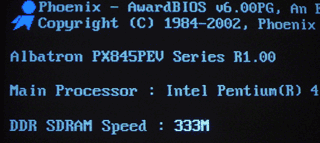Intel announces DDR333 Chipsets: 3-way 845PE shootout
by Evan Lieb on October 7, 2002 5:22 AM EST- Posted in
- Motherboards
The Chipsets
Intel's announcement today encompasses four total chipset announcements: 845PE, 845GE, 845GV and 850E w/ PC1066 support. The improvements to the chipsets are minimal and are mostly on the validation side of things but they are what separate these additions from those that were available just a few weeks ago.
We'll start with the 845PE, which will become a very popular enthusiast class chipset. The 845PE's only improvement over the 845E is its official support for DDR333 SDRAM, which you will remember was absent in the original 845E. The addition of DDR333 support completes the requirement list for the chipset, as its South Bridge already supports USB 2.0. In fact, the only thing the 845PE is missing is AGP 8X support which has failed to offer any real performance improvement even with AGP 8X graphics cards. The lack of any integrated graphics core means that 845PE boards can be had for relatively low prices; combined with the stability of the chipset and the drivers, this could be the chipset to get for an affordable Pentium 4 system.

Finally, an 845E with official DDR333 support
The 845GE adds official DDR333 support to the 845G chipset, although the original 845G had unofficial support for the memory. As the name implies, the 845GE is basically an 845PE but with Intel's integrated graphics core. The 845GE improves graphics performance a bit by increasing the core clock from 200MHz to 266MHz. The increase in core clock will help performance a bit but the graphics performance is still very low by gamer standards.
The final member of the new 845 series is the 845GV, a successor to the 845GL chipset. The 845GV adds 533MHz FSB support while retaining the old 200MHz graphics core from the original 845G. Just like the 845GL, the GV does not support an external AGP interface in order to reduce pin count (and thus cost). You won't find the 845GV in many non-OEM solutions as it is quite upgrade limited.
Intel is also finally announcing official support for PC1066 RDRAM with the 850E chipset. The 850E with PC1066 support will not receive a new name; it will be up to motherboard manufacturers to put their stamp of PC1066 approval on their 850E boards. Unfortunately, the 850E still doesn't gain the use of Intel's USB 2.0 equipped ICH4.
|
Chipset Feature Comparison |
||||||
|
Chipset
|
Integrated
Graphics
|
FSB
|
Memory
|
AGP
|
USB2/Firewire
|
Hyper-Threading
|
|
Intel
845
|
N
|
400MHz
|
DDR266
|
4X
|
N/N
|
N
|
|
Intel
845E
|
N
|
533MHz
|
DDR266
|
4X
|
Y/N
|
Y
|
|
Intel
845G
|
Y
|
533MHz
|
DDR266
|
4X
|
Y/N
|
Y*
|
| Intel 845PE |
N
|
533MHz
|
DDR333
|
4X
|
Y/N
|
Y
|
| Intel 845GE |
Y
|
533MHz
|
DDR333
|
4X
|
Y/N
|
Y
|
| Intel 850 |
N
|
400MHz
|
PC800
|
4X
|
N/N
|
N
|
| Intel 850E |
N
|
533MHz
|
PC1066
|
4X
|
N/N
|
Y
|
| SiS 645DX |
N
|
533MHz
|
DDR333
|
4X
|
Y/N
|
?
|
| SiS 648 |
N
|
533MHz
|
DDR333
|
8X
|
Y/Y
|
?
|
| VIA P4X400 |
N
|
533MHz
|
DDR400
|
8X
|
Y/N
|
?
|
* 845G A-stepping does not support HT
All in all the new chipsets are not all that "new" but rather things we should have seen long ago from Intel. With both SiS and VIA beating Intel to the punch with DDR333 support, we'd expect more from an industry leader like Intel outside of showing up to the DDR game months behind the Taiwanese competition. Intel's validation procedures are quite strenuous but that's still not much of an excuse for being this late to market.










0 Comments
View All Comments